JAJS845D March 1998 – May 2016 LM2597 , LM2597HV
PRODUCTION DATA.
- 1 特長
- 2 アプリケーション
- 3 概要
- 4 改訂履歴
- 5 概要(続き)
- 6 Pin Configuration and Functions
-
7 Specifications
- 7.1 Absolute Maximum Ratings
- 7.2 ESD Ratings
- 7.3 Recommended Operating Conditions
- 7.4 Thermal Information
- 7.5 Electrical Characteristics - 3.3 V
- 7.6 Electrical Characteristics - 5 V
- 7.7 Electrical Characteristics - 12 V
- 7.8 Electrical Characteristics - Adjustable
- 7.9 Electrical Characteristics - All Output Voltage Versions
- 7.10 Typical Characteristics
- 8 Detailed Description
- 9 Application and Implementation
- 10Power Supply Recommendations
- 11Layout
- 12デバイスおよびドキュメントのサポート
- 13メカニカル、パッケージ、および注文情報
パッケージ・オプション
メカニカル・データ(パッケージ|ピン)
サーマルパッド・メカニカル・データ
発注情報
9 Application and Implementation
NOTE
Information in the following applications sections is not part of the TI component specification, and TI does not warrant its accuracy or completeness. TI’s customers are responsible for determining suitability of components for their purposes. Customers should validate and test their design implementation to confirm system functionality.
9.1 Application Information
9.1.1 Soft-Start Capacitor, CSS
A capacitor on this pin provides the regulator with a soft-start feature (slow start-up). When the DC input voltage is first applied to the regulator, or when the Shutdown/Soft-start pin is allowed to go high, a constant current (approximately 5 μA begins charging this capacitor). As the capacitor voltage rises, the regulator goes through four operating regions (see the bottom curve in Figure 31).
- Regulator in Shutdown – When the SD/SS pin voltage is between 0 V and 1.3 V, the regulator is in shutdown, the output voltage is zero, and the IC quiescent current is approximately 85 μA.
- Regulator ON, but the output voltage is zero – With the SD/SS pin voltage between approximately 1.3 V and 1.8 V, the internal regulatory circuitry is operating, the quiescent current rises to approximately 5 mA, but the output voltage is still zero. Also, as the 1.3-V threshold is exceeded, the soft-start capacitor charging current decreases from 5 μA down to approximately 1.6 μA. This decreases the slope of capacitor voltage ramp.
- Soft-start Region – When the SD/SS pin voltage is between 1.8 V and 2.8 V (at 25°C), the regulator is in a soft-start condition. The switch (Pin 8) duty cycle initially starts out very low, with narrow pulses and gradually get wider as the capacitor SD/SS pin ramps up towards 2.8 V. As the duty cycle increases, the output voltage also increases at a controlled ramp up. See the center curve in Figure 31. The input supply current requirement also starts out at a low level for the narrow pulses and ramp up in a controlled manner. This is a very useful feature in some switcher topologies that require large start-up currents (such as the inverting configuration) which can load down the input power supply.
- Normal operation – Above 2.8 V, the circuit operates as a standard Pulse Width Modulated switching regulator. The capacitor will continue to charge up until it reaches the internal clamp voltage of approximately 7 V. If this pin is driven from a voltage source, the current must limit to about 1 mA.
If the part is operated with an input voltage at or below the internal soft-start clamp voltage of approximately 7 V, the voltage on the SD/SS pin tracks the input voltage and can be disturbed by a step in the voltage. To maintain proper function under these conditions, TI strongly recommends clamping the SD/SS pin externally between the 3-V maximum soft-start threshold and the 4.5-V minimum input voltage. Figure 32 is an example of an external 3.7 V (approximately) clamp that prevents a line-step related glitch but does not interfere with the soft-start behavior of the device.
NOTE
The lower curve shown in Figure 31 shows the soft-start region from 0% to 100%. This is not the duty cycle percentage, but the output voltage percentage. Also, the soft-start voltage range has a negative temperature coefficient associated with it. See the soft-start curve in Electrical Characteristics.
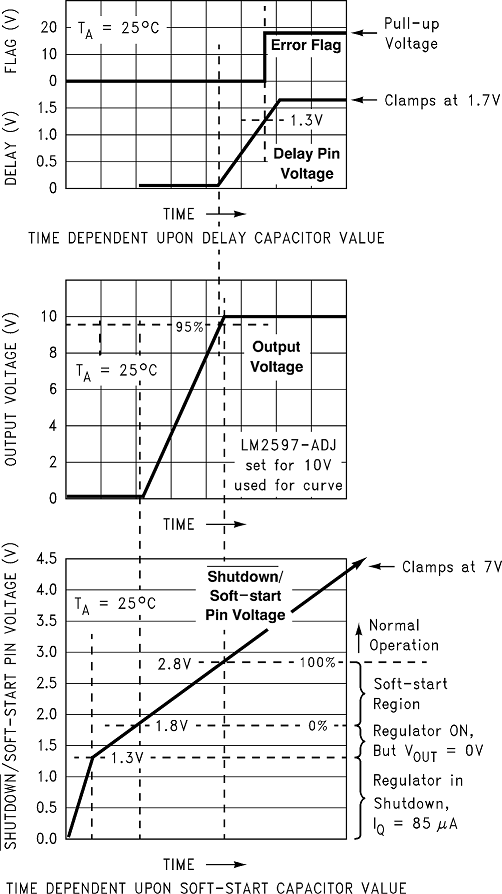 Figure 31. Soft-Start, Delay, Error, and Output
Figure 31. Soft-Start, Delay, Error, and Output
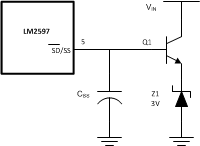 Figure 32. External 3.7-V Soft-Start Clamp
Figure 32. External 3.7-V Soft-Start Clamp
9.1.2 Delay Capacitor, CDELAY
Provides delay for the error flag output. See the upper curve in Figure 31, and also refer to timing diagrams in Figure 33. A capacitor on this pin provides a time delay between the time the regulated output voltage (when it is increasing in value) reaches 95% of the nominal output voltage, and the time the error flag output goes high. A 3-μA constant current from the delay pin charges the delay capacitor resulting in a voltage ramp. When this voltage reaches a threshold of approximately 1.3 V, the open collector error flag output (or power OK) goes high. This signal can be used to indicate that the regulated output has reached the correct voltage and has stabilized.
If, for any reason, the regulated output voltage drops by 5% or more, the error output flag (Pin 1) immediately goes low (internal transistor turns on). The delay capacitor provides very little delay if the regulated output is dropping out of regulation. The delay time for an output that is decreasing is approximately a 1000 times less than the delay for the rising output. For a 0.1-μF delay capacitor, the delay time would be approximately 50 ms when the output is rising and passes through the 95% threshold, but the delay for the output dropping would only be approximately 50 μs.
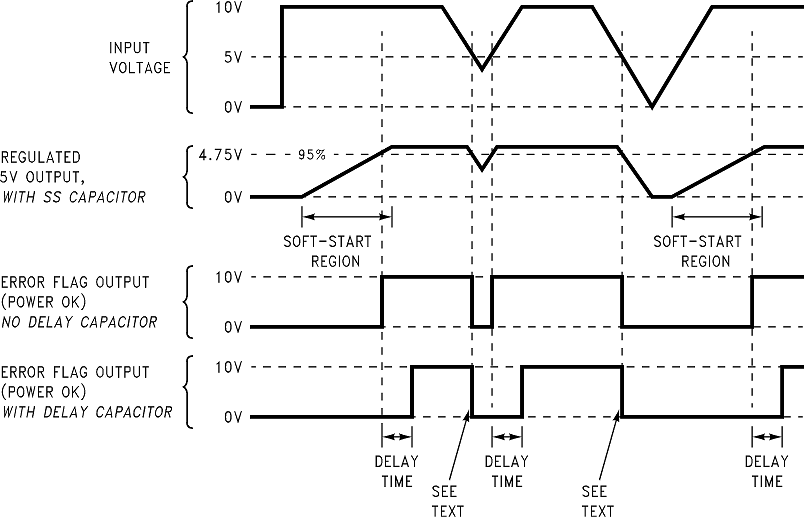 Figure 33. Timing Diagram for 5-V Output
Figure 33. Timing Diagram for 5-V Output
9.1.2.1 RPULLUP
The error flag output, (or power OK) is the collector of a NPN transistor, with the emitter internally grounded. To use the error flag, a pullup resistor to a positive voltage is required. The error flag transistor is rated up to a maximum of 45 V and can sink approximately 3 mA. If the error flag is not used, it can be left open.
9.1.3 Input Capacitor, CIN
A low ESR aluminum or tantalum bypass capacitor is required between the input pin and ground pin. The capacitor must be located near the regulator using short leads. This capacitor prevents large voltage transients from appearing at the input, and provides the instantaneous current required each time the switch turns on.
The important parameters for the Input capacitor are the voltage rating and the RMS current rating. Because of the relatively high RMS currents flowing in a input capacitor of a buck regulator, this capacitor must be chosen for its RMS current rating rather than its capacitance or voltage ratings, although the capacitance value and voltage rating are directly related to the RMS current rating.
The RMS current rating of a capacitor could be viewed as a power rating of the capacitor. The RMS current flowing through the capacitors internal ESR produces power which causes the internal temperature of the capacitor to rise. The RMS current rating of a capacitor is determined by the amount of current required to raise the internal temperature approximately 10°C above an ambient temperature of 105°C. The ability of the capacitor to dissipate this heat to the surrounding air will determine the amount of current the capacitor can safely sustain. Capacitors that are physically large and have a large surface area will typically have higher RMS current ratings. For a given capacitor value, a higher voltage electrolytic capacitor will be physically larger than a lower voltage capacitor, and thus be able to dissipate more heat to the surrounding air, and therefore will have a higher RMS current rating.
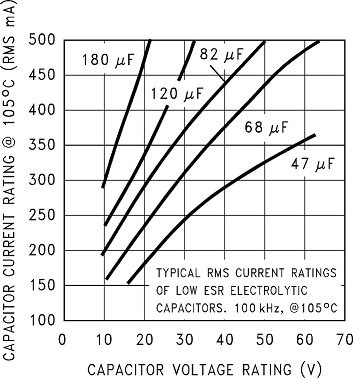 Figure 34. RMS Current Ratings for
Figure 34. RMS Current Ratings for Low ESR Electrolytic Capacitors (Typical)
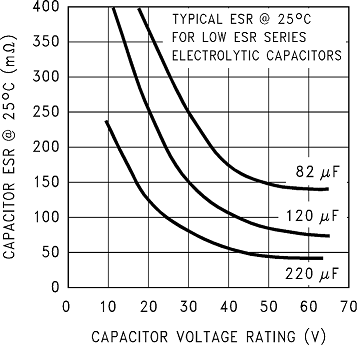
(Typical Low ESR Electrolytic Capacitor)
The consequences of operating an electrolytic capacitor above the RMS current rating is a shortened operating life. The higher temperature speeds up the evaporation of the electrolyte of the capacitor, resulting in eventual failure.
Selecting an input capacitor requires consulting the manufacturers data sheet for maximum allowable RMS ripple current. For a maximum ambient temperature of 40°C, a general guideline would be to select a capacitor with a ripple current rating of approximately 50% of the DC load current. For ambient temperatures up to 70°C, a current rating of 75% of the DC load current would be a good choice for a conservative design. The capacitor voltage rating must be at least 1.25 times greater than the maximum input voltage, and often a much higher voltage capacitor is required to satisfy the RMS current requirements.
Figure 34 shows the relationship between an electrolytic capacitor value, its voltage rating, and the RMS current it is rated for. These curves were obtained from the Nichicon PL series of low-ESR, high-reliability electrolytic capacitors designed for switching regulator applications. Other capacitor manufacturers offer similar types of capacitors, but always check the capacitor data sheet.
Standard electrolytic capacitors typically have much higher ESR numbers, lower RMS current ratings and typically have a shorter operating lifetime.
Because of their small size and excellent performance, surface-mount solid tantalum capacitors are often used for input bypassing, but several precautions must be observed. A small percentage of solid tantalum capacitors can short if the inrush current rating is exceeded. This can happen at turnon when the input voltage is suddenly applied, and of course, higher input voltages produce higher inrush currents. Several capacitor manufacturers do a 100% surge current testing on their products to minimize this potential problem. If high turnon currents are expected, it may be necessary to limit this current by adding either some resistance or inductance before the tantalum capacitor, or select a higher voltage capacitor. As with aluminum electrolytic capacitors, the RMS ripple current rating must be sized to the load current.
9.1.4 Output Capacitor, COUT
An output capacitor is required to filter the output and provide regulator loop stability. Use a low impedance or low ESR Electrolytic or solid tantalum capacitors designed for switching regulator applications. When selecting an output capacitor, the important capacitor parameters are; the 100-kHz Equivalent Series Resistance (ESR), the RMS ripple current rating, voltage rating, and capacitance value. For the output capacitor, the ESR value is the most important parameter.
The output capacitor requires an ESR value that has an upper and lower limit. For low output ripple voltage, a low ESR value is required. This value is determined by the maximum allowable output ripple voltage, typically 1% to 2% of the output voltage. But if the ESR of the selected capacitor is extremely low, there is a possibility of an unstable feedback loop, resulting in an oscillation at the output. Using the capacitors listed in the tables, or similar types, will provide design solutions under all conditions.
If very low output ripple voltage (less than 15 mV) is required, see Output Voltage Ripple and Transients for a post ripple filter.
An aluminum electrolytic capacitor's ESR value is related to the capacitance value and its voltage rating. In most cases, Higher voltage electrolytic capacitors have lower ESR values (see Figure 35). Often, capacitors with much higher voltage ratings are required to provide the low ESR values required for low output ripple voltage.
The output capacitor for many different switcher designs are often satisfied with only three or four different capacitor values and several different voltage ratings. See Table 4 and Table 6 for typical capacitor values, voltage ratings, and manufacturers capacitor types.
Electrolytic capacitors are not recommended for temperatures below −25°C. The ESR rises dramatically at cold temperatures and typically rises 3X at −25°C and as much as 10X at −40°C (see Figure 36).
Solid tantalum capacitors have a much better ESR specifications for cold temperatures and are recommended for temperatures below −25°C.
9.1.5 Catch Diode
Buck regulators require a diode to provide a return path for the inductor current when the switch turns off. This must be a fast diode, located close to the LM2594 using short leads and short printed-circuit traces.
Because of their very fast switching speed and low forward voltage drop, Schottky diodes provide the best performance, especially in low output voltage applications (5 V and lower). Ultra-fast recovery, or high-efficiency rectifiers are also a good choice, but some types with an abrupt turnoff characteristic may cause instability or EMI problems. Ultra-fast recovery diodes typically have reverse recovery times of 50 ns or less. Rectifiers such as the 1N4001 series are much too slow and must not be used.
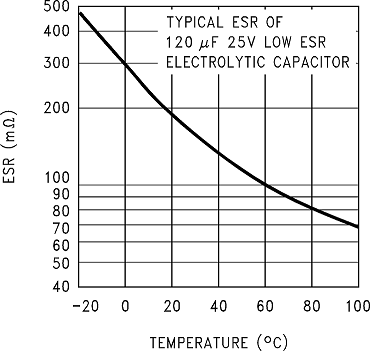 Figure 36. Capacitor ESR Change vs Temperature
Figure 36. Capacitor ESR Change vs Temperature
Table 1. Diode Selection Table
| VR | 1-A DIODES | |||
|---|---|---|---|---|
| SURFACE-MOUNT | THROUGH-HOLE | |||
| SCHOTTKY | ULTRA FAST RECOVERY | SCHOTTKY | ULTRA FAST RECOVERY | |
| 20 V | All of these diodes are rated to at least 60 V. |
1N5817 | All of these diodes are rated to at least 60 V. |
|
| SR102 | ||||
| 30 V | MBRS130 | 1N5818 | ||
| SR103 | ||||
| 11DQ03 | ||||
| 40 V | MBRS140 | MURS120 10BF10 |
1N5819 | HER101 MUR120 11DF1 |
| 10BQ040 | SR104 | |||
| 10MQ040 | 11DQ04 | |||
| 50 V or more |
MBRS160 | SR105 | ||
| 10BQ050 | MBR150 | |||
| 10MQ060 | 11DQ05 | |||
| MBRS1100 | MBR160 | |||
| 10MQ090 | SB160 | |||
| SGL41-60 | 11DQ10 | |||
| SS16 | ||||
9.1.6 Inductor Selection
All switching regulators have two basic modes of operation: continuous and discontinuous. The difference between the two types relates to the inductor current, whether it is flowing continuously, or if it drops to zero for a period of time in the normal switching cycle. Each mode has distinctively different operating characteristics, which can affect the regulators performance and requirements. Most switcher designs will operate in the discontinuous mode when the load current is low.
The LM2597 (or any of the SIMPLE SWITCHER family) can be used for both continuous or discontinuous modes of operation.
In many cases the preferred mode of operation is the continuous mode. This mode offers greater output power, lower peak switch, inductor, and diode currents, and can have lower output ripple voltage. However, the continuous mode requires larger inductor values to keep the inductor current flowing continuously, especially at low output load currents or high input voltages.
To simplify the inductor selection process, an inductor selection guide (nomograph) was designed. This guide assumes that the regulator is operating in the continuous mode, and selects an inductor that will allow a peak-to-peak inductor ripple current to be a certain percentage of the maximum design load current. This peak-to-peak inductor ripple current percentage is not fixed, but is allowed to change as different design load currents are selected (see Figure 37).
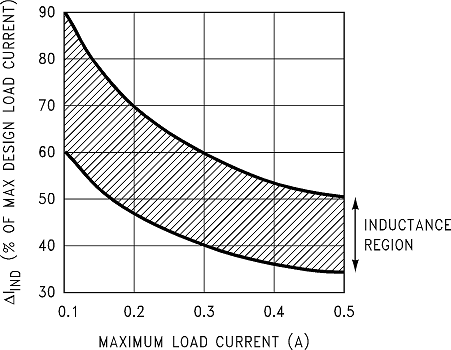 Figure 37. (ΔIIND) Peak-to-Peak Inductor Ripple Current
Figure 37. (ΔIIND) Peak-to-Peak Inductor Ripple Current(as a Percentage of the Load Current) vs Load Current
By allowing the percentage of inductor ripple current to increase for low load currents, the inductor value and size can be kept relatively low.
When operating in the continuous mode, the inductor current waveform ranges from a triangular to a sawtooth type of waveform (depending on the input voltage), with the average value of this current waveform equal to the DC output load current.
Inductors are available in different styles such as pot core, toroid, E-core, bobbin core, and so forth, as well as different core materials, such as ferrites and powdered iron. The least expensive, the bobbin, rod or stick core, consists of wire wrapped on a ferrite bobbin. This type of construction makes for a inexpensive inductor; however, because the magnetic flux is not completely contained within the core, it generates more Electro-Magnetic Interference (EMl). This magnetic flux can induce voltages into nearby printed-circuit traces, thus causing problems with both the switching regulator operation and nearby sensitive circuitry, and can give incorrect scope readings because of induced voltages in the scope probe (see Open Core Inductors).
The inductors listed in the selection chart include ferrite E-core construction for Schott, ferrite bobbin core for Renco and Coilcraft, and powdered iron toroid for Pulse Engineering.
Exceeding the maximum current rating of an inductor may cause the inductor to overheat because of the copper wire losses, or the core may saturate. If the inductor begins to saturate, the inductance decreases rapidly and the inductor begins to look mainly resistive (the DC resistance of the winding). This can cause the switch current to rise very rapidly and force the switch into a cycle-by-cycle current limit, thus reducing the DC output load current. This can also result in overheating of the inductor and the LM2597. Different inductor types have different saturation characteristics, so consider this when selecting an inductor.
The inductor manufacturers data sheets include current and energy limits to avoid inductor saturation.
For continuous mode operation, see the inductor selection graphs in Figure 38 through Figure 41
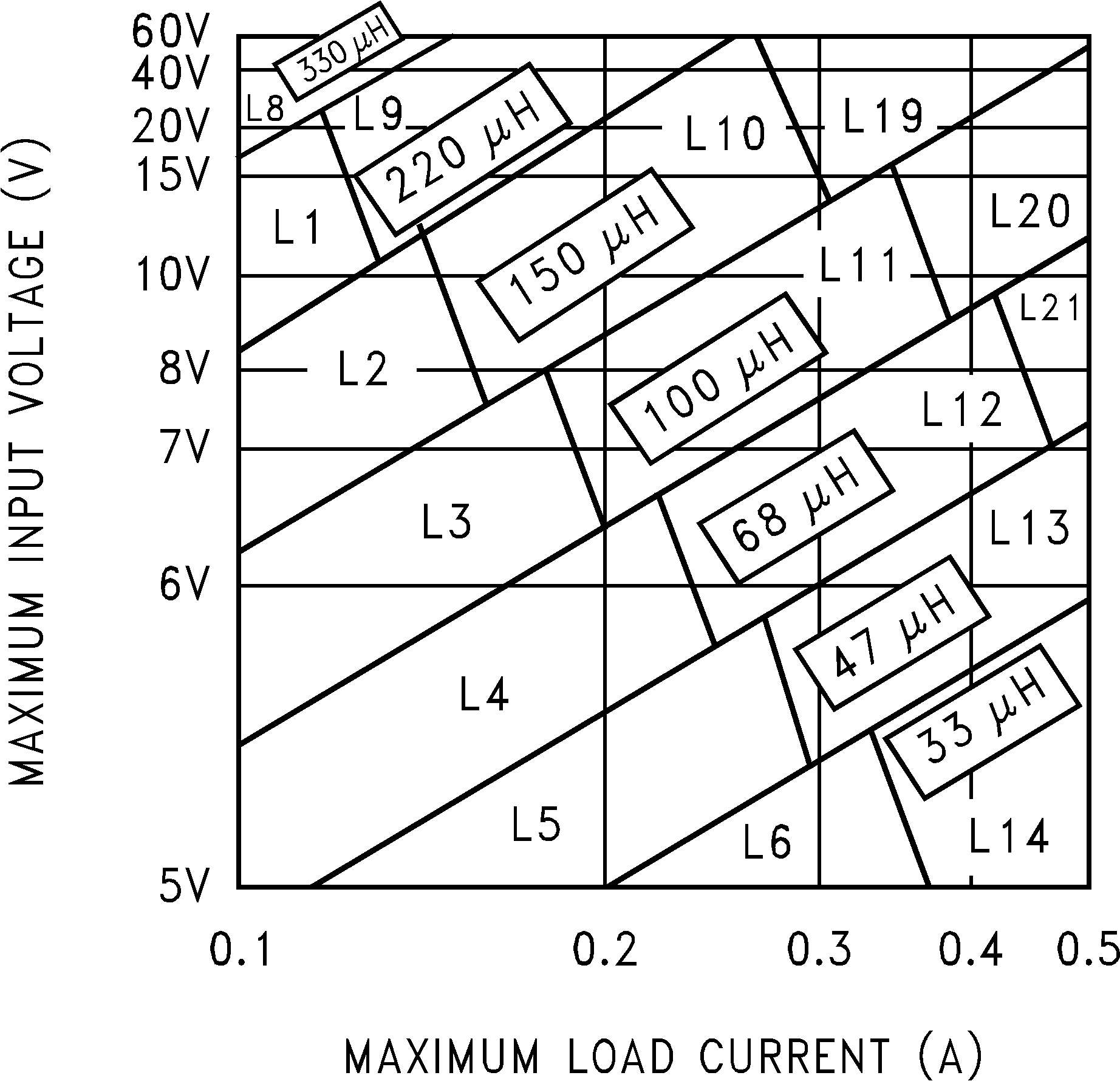 Figure 38. LM2597xx 3.3-V Version
Figure 38. LM2597xx 3.3-V Version
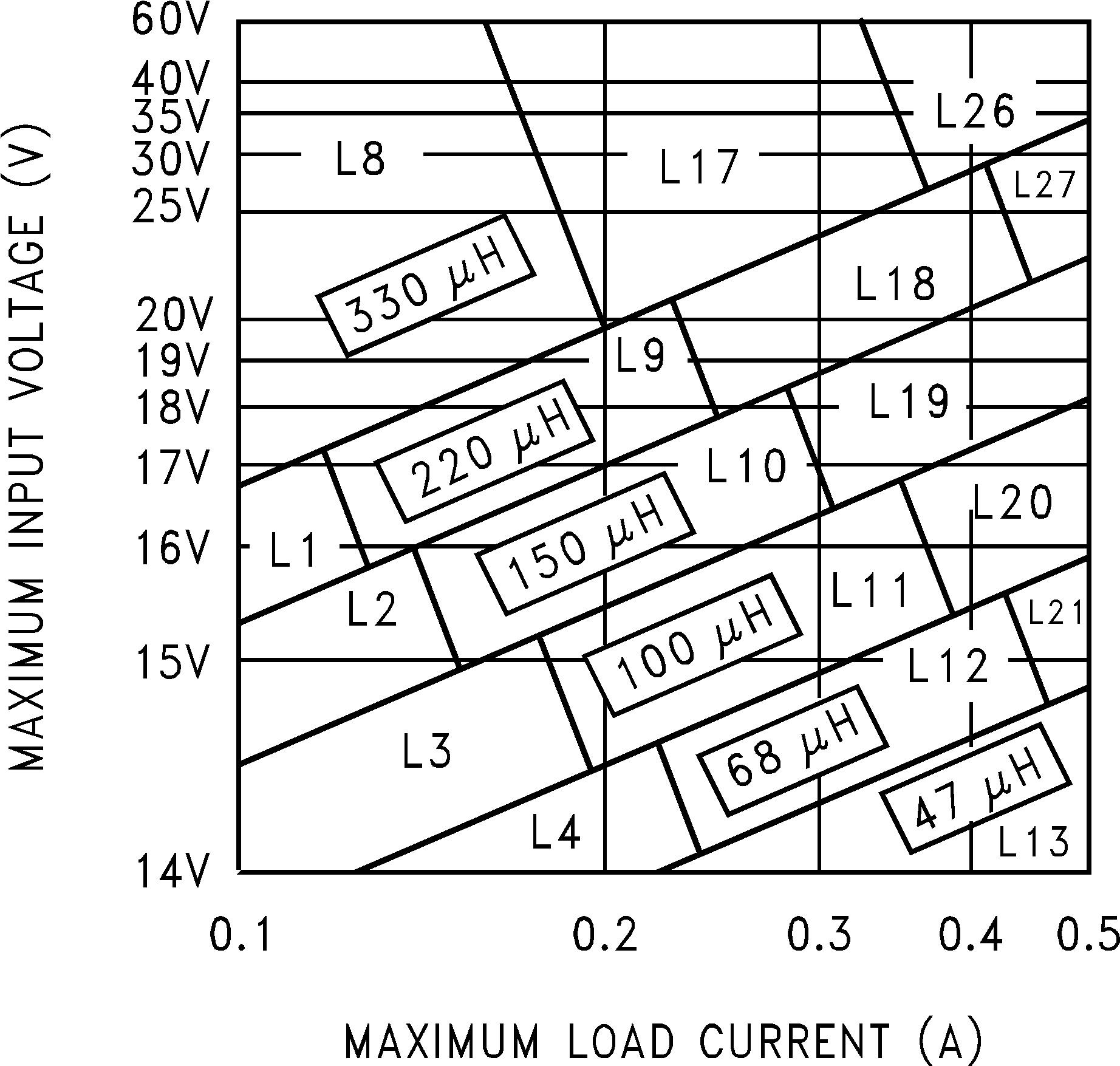 Figure 40. LM2597xx 12-V Version
Figure 40. LM2597xx 12-V Version
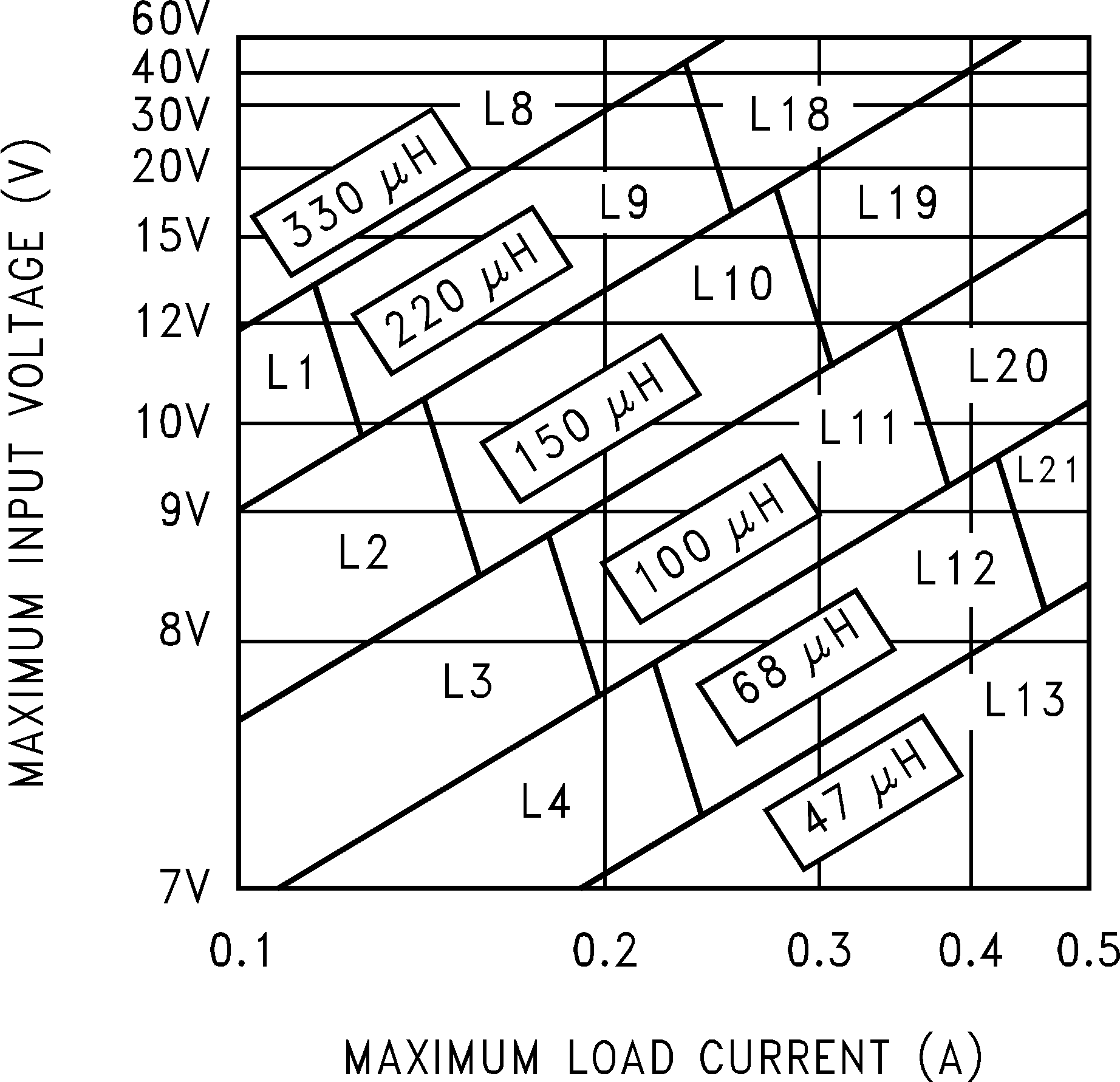 Figure 39. LM2597xx 5-V Version
Figure 39. LM2597xx 5-V Version
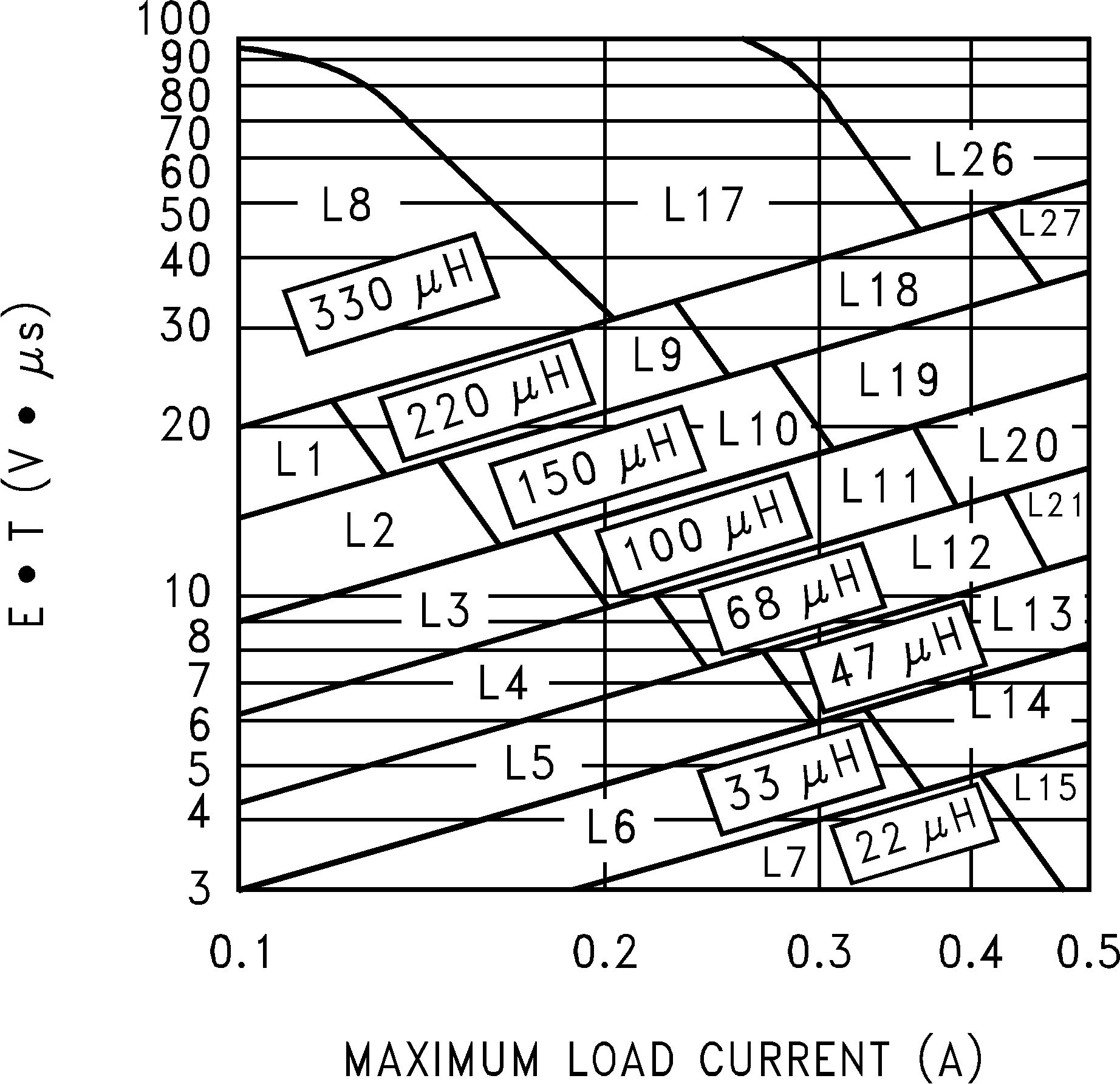 Figure 41. LM2597xx Adjustable Voltage Version
Figure 41. LM2597xx Adjustable Voltage Version
Table 2. Inductor Manufacturers' Part Numbers
| INDUCTANCE (μH) |
CURRENT (A) |
SCHOTT | RENCO | PULSE ENGINEERING | COILCRAFT | ||||
|---|---|---|---|---|---|---|---|---|---|
| THROUGH-HOLE | SURFACE-MOUNT | THROUGH-HOLE | SURFACE-MOUNT | THROUGH-HOLE | SURFACE-MOUNT | SURFACE-MOUNT | |||
| L1 | 220 | 0.18 | 67143910 | 67144280 | RL-5470-3 | RL1500-220 | PE-53801 | PE-53801-S | DO1608-224 |
| L2 | 150 | 0.21 | 67143920 | 67144290 | RL-5470-4 | RL1500-150 | PE-53802 | PE-53802-S | DO1608-154 |
| L3 | 100 | 0.26 | 67143930 | 67144300 | RL-5470-5 | RL1500-100 | PE-53803 | PE-53803-S | DO1608-104 |
| L4 | 68 | 0.32 | 67143940 | 67144310 | RL-1284-68 | RL1500-68 | PE-53804 | PE-53804-S | DO1608-68 |
| L5 | 47 | 0.37 | 67148310 | 67148420 | RL-1284-47 | RL1500-47 | PE-53805 | PE-53805-S | DO1608-473 |
| L6 | 33 | 0.44 | 67148320 | 67148430 | RL-1284-33 | RL1500-33 | PE-53806 | PE-53806-S | DO1608-333 |
| L7 | 22 | 0.6 | 67148330 | 67148440 | RL-1284-22 | RL1500-22 | PE-53807 | PE-53807-S | DO1608-223 |
| L8 | 330 | 0.26 | 67143950 | 67144320 | RL-5470-2 | RL1500-330 | PE-53808 | PE-53808-S | DO3308-334 |
| L9 | 220 | 0.32 | 67143960 | 67144330 | RL-5470-3 | RL1500-220 | PE-53809 | PE-53809-S | DO3308-224 |
| L10 | 150 | 0.39 | 67143970 | 67144340 | RL-5470-4 | RL1500-150 | PE-53810 | PE-53810-S | DO3308-154 |
| L11 | 100 | 0.48 | 67143980 | 67144350 | RL-5470-5 | RL1500-100 | PE-53811 | PE-53811-S | DO3308-104 |
| L12 | 68 | 0.58 | 67143990 | 67144360 | RL-5470-6 | RL1500-68 | PE-53812 | PE-53812-S | DO1608-683 |
| L13 | 47 | 0.7 | 67144000 | 67144380 | RL-5470-7 | RL1500-47 | PE-53813 | PE-53813-S | DO3308-473 |
| L14 | 33 | 0.83 | 67148340 | 67148450 | RL-1284-33 | RL1500-33 | PE-53814 | PE-53814-S | DO1608-333 |
| L15 | 22 | 0.99 | 67148350 | 67148460 | RL-1284-22 | RL1500-22 | PE-53815 | PE-53815-S | DO1608-223 |
| L16 | 15 | 1.24 | 67148360 | 67148470 | RL-1284-15 | RL1500-15 | PE-53816 | PE-53816-S | DO1608-153 |
| L17 | 330 | 0.42 | 67144030 | 67144410 | RL-5471-1 | RL1500-330 | PE-53817 | PE-53817-S | DO3316-334 |
| L18 | 220 | 0.55 | 67144040 | 67144420 | RL-5471-2 | RL1500-220 | PE-53818 | PE-53818-S | DO3316-224 |
| L19 | 150 | 0.66 | 67144050 | 67144430 | RL-5471-3 | RL1500-150 | PE-53819 | PE-53819-S | DO3316-154 |
| L20 | 100 | 0.82 | 67144060 | 67144440 | RL-5471-4 | RL1500-100 | PE-53820 | PE-53820-S | DO3316-104 |
| L21 | 68 | 0.99 | 67144070 | 67144450 | RL-5471-5 | RL1500-68 | PE-53821 | PE-53821-S | DDO3316-683 |
| L26 | 330 | 0.8 | 67144100 | 67144480 | RL-5471-1 | — | PE-53826 | PE-53826-S | — |
| L27 | 220 | 1 | 67144110 | 67144490 | RL-5471-2 | — | PE-53827 | PE-53827-S | — |
9.1.7 Output Voltage Ripple and Transients
The output voltage of a switching power supply operating in the continuous mode will contain a sawtooth ripple voltage at the switcher frequency, and may also contain short voltage spikes at the peaks of the sawtooth waveform.
The output ripple voltage is a function of the inductor sawtooth ripple current and the ESR of the output capacitor. A typical output ripple voltage can range from approximately 0.5% to 3% of the output voltage. To obtain low ripple voltage, the ESR of the output capacitor must be low; however, caution must be exercised when using extremely low ESR capacitors because they can affect the loop stability, resulting in oscillation problems. If very low output ripple voltage is required (less than 15 mV), TI recommends a post ripple filter (see Figure 46). The inductance required is typically between 1 μH and 5 μH, with low DC resistance, to maintain good load regulation. A low ESR output filter capacitor is also required to assure good dynamic load response and ripple reduction. The ESR of this capacitor may be as low as desired, because it is out of the regulator feedback loop. Figure 30 shows a typical output ripple voltage, with and without a post ripple filter.
When observing output ripple with a scope, it is essential that a short, low inductance scope probe ground connection be used. Most scope probe manufacturers provide a special probe terminator which is soldered onto the regulator board, preferably at the output capacitor. This provides a very short scope ground, thus eliminating the problems associated with the 3 inch ground lead normally provided with the probe, and provides a much cleaner and more accurate picture of the ripple voltage waveform.
The voltage spikes are caused by the fast switching action of the output switch, the diode, the parasitic inductance of the output filter capacitor, and its associated wiring. To minimize these voltage spikes, the output capacitor must be designed for switching regulator applications, and the lead lengths must be kept very short. Wiring inductance, stray capacitance, as well as the scope probe used to evaluate these transients, all contribute to the amplitude of these spikes.
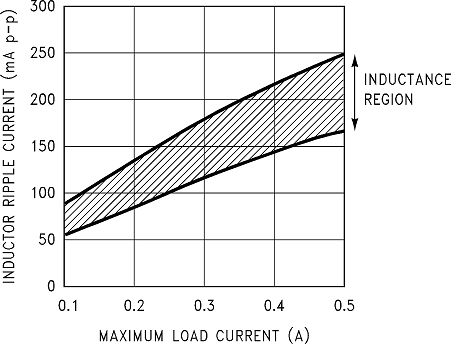 Figure 42. Peak-to-Peak Inductor
Figure 42. Peak-to-Peak InductorRipple Current vs Load Current
When a switching regulator is operating in the continuous mode, the inductor current waveform ranges from a triangular to a sawtooth type of waveform (depending on the input voltage). For a given input and output voltage, the peak-to-peak amplitude of this inductor current waveform remains constant. As the load current increases or decreases, the entire sawtooth current waveform also rises and falls. The average value (or the center) of this current waveform is equal to the DC load current.
If the load current drops to a low enough level, the bottom of the sawtooth current waveform reaches zero, and the switcher will smoothly change from a continuous to a discontinuous mode of operation. Most switcher designs (regardless how large the inductor value is) will be forced to run discontinuous if the output is lightly loaded. This is a perfectly acceptable mode of operation.
In a switching regulator design, knowing the value of the peak-to-peak inductor ripple current (ΔIIND) can be useful for determining a number of other circuit parameters. Parameters such as, peak inductor or peak switch current, minimum load current before the circuit becomes discontinuous, output ripple voltage and output capacitor ESR can all be calculated from the peak-to-peak ΔIIND. When the inductor nomographs shown in Figure 38 through Figure 41 are used to select an inductor value, the peak-to-peak inductor ripple current can immediately be determined. Figure 42 shows the range of (ΔIIND) that can be expected for different load currents. Figure 42 also shows how the peak-to-peak inductor ripple current (ΔIIND) changes as the designer goes from the lower border to the upper border (for a given load current) within an inductance region. The upper border represents a higher input voltage, while the lower border represents a lower input voltage (see Inductor Selection).
These curves are only correct for continuous mode operation, and only if the inductor selection guides are used to select the inductor value
Consider the following example:
VOUT = 5 V, maximum load current of 300 mA
VIN = 15 V (nominal), varying between 11 V and 20 V
The selection guide in Figure 39 shows that the vertical line for a 0.3-A load current and the horizontal line for the 15-V input voltage intersect approximately midway between the upper and lower borders of the 150-μH inductance region. A 150-μH inductor allows a peak-to-peak inductor current (ΔIIND) to flow a percentage of the maximum load current. Referring to Figure 42, follow the 0.3-A line approximately midway into the inductance region, and read the peak-to-peak inductor ripple current (ΔIIND) on the left hand axis (approximately 150 mAp-p).
As the input voltage increases to 20 V, it approaches the upper border of the inductance region, and the inductor ripple current increases. Figure 42 shows that for a load current of 0.3 A, the peak-to-peak inductor ripple current (ΔIIND) is 150 mA with 15 VIN, and can range from 175 mA at the upper border (20 VIN) to 120 mA at the lower border (11 VIN).
Once the ΔIIND value is known, the following formulas can be used to calculate additional information about the switching regulator circuit.
- Peak Inductor or peak switch current

- Minimum load current before the circuit becomes discontinuous

- Output Ripple Voltage
- = (ΔIIND) × (ESR of COUT)
- = 0.150 A × 0.240 Ω = 36 mVp-p
- or
- ESR of COUT
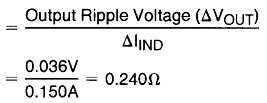
9.1.8 Open Core Inductors
Another possible source of increased output ripple voltage or unstable operation is from an open-core inductor. Ferrite bobbin or stick inductors have magnetic lines of flux flowing through the air from one end of the bobbin to the other end. These magnetic lines of flux will induce a voltage into any wire or PCB copper trace that comes within the magnetic field of the inductor. The strength of the magnetic field, the orientation and location of the PC copper trace to the magnetic field, and the distance between the copper trace and the inductor determine the amount of voltage generated in the copper trace. Another way of looking at this inductive coupling is to consider the PCB copper trace as one turn of a transformer (secondary) with the inductor winding as the primary. Many millivolts can be generated in a copper trace located near an open-core inductor, which can cause stability problems or high output ripple voltage problems.
If unstable operation is seen, and an open core inductor is used, it is possible that the location of the inductor with respect to other PC traces may be the problem. To determine if this is the problem, temporarily raise the inductor away from the board by several inches and then check circuit operation. If the circuit now operates correctly, then the magnetic flux from the open-core inductor is causing the problem. Substituting a closed-core inductor such as a torroid or E-core will correct the problem, or re-arranging the PC layout may be necessary. Magnetic flux cutting the IC device ground trace, feedback trace, or the positive or negative traces of the output capacitor must be minimized.
Sometimes, placing a trace directly beneath a bobbin inductor will provide good results, provided it is exactly in the center of the inductor (because the induced voltages cancel themselves out). However, problems could arise if the trace is off center. If flux problems are present, even the direction of the inductor winding can make a difference in some circuits.
This discussion on open-core inductors is not to frighten users, but to alert them on what kind of problems to watch out for. Open-core bobbin or stick inductors are an inexpensive, simple way of making a compact, efficient inductor, and they are used by the millions in many different applications.
9.2 Typical Applications
9.2.1 Series Buck Regulator (Fixed Output)
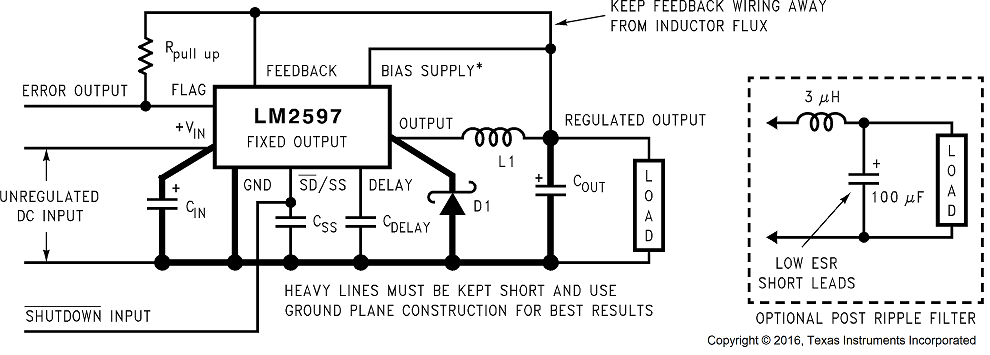
CIN – 47-μF, 50-V, Aluminum Electrolytic Nichico L Series
COUT – 120-μF, 25-V Aluminum Electrolytic, Nichicon PL Series
D1 – 1–A, 30–V Schottky Rectif 1N5818
L1 – 100-μH, L20
Typical Values
CSS – 0.1 μF
CDELAY – 0.1 μF
RPull Up – 4.7k
*Use bias supply pin for 5-V and 12-V versions
9.2.1.1 Design Requirements
Table 3 lists the design parameters for this application example.
Table 3. Design Parameters
| PARAMETER | EXAMPLE VALUE |
|---|---|
| Regulated output voltage (3.3 V, 5 V or 12 V), VOUT | 5 V |
| Maximum DC input voltage, VIN(max) | 12 V |
| Maximum load current, ILOAD(max) | 0.4 A |
9.2.1.2 Detailed Design Procedure
9.2.1.2.1 Inductor Selection (L1)
- Select the correct inductor value selection guide from Figure 38, Figure 39, or Figure 40 (output voltages of 3.3 V, 5 V, or 12 V respectively). For all other voltages, see the design procedure for the adjustable version.
- From the inductor value selection guide, identify the inductance region intersected by the maximum input voltage line and the maximum load current line. Each region is identified by an inductance value and an inductor code (LXX).
- Select an appropriate inductor from the four manufacturer's part numbers listed in Table 2.
Use the inductor selection guide for the 5-V version shown in Figure 39.
From the inductor value selection guide shown in Figure 39, the inductance region intersected by the 12-V horizontal line and the 0.4-A vertical line is 100 μH, and the inductor code is L20.
The inductance value required is 100 μH. See row L20 of Table 2 and choose an inductor part number from any of the four manufacturers shown. (In most instance, both through-hole and surface-mount inductors are available.)
9.2.1.2.2 Output Capacitor Selection (COUT)
- In the majority of applications, low ESR (Equivalent Series Resistance) electrolytic capacitors between 82 μF and 220 μF and low ESR solid tantalum capacitors between 15 μF and 100 μF provide the best results. This capacitor must be located close to the IC using short capacitor leads and short copper traces. Do not use capacitors larger than 220 μF.
- To simplify the capacitor selection procedure, see Table 4 for quick design component selection. This table contains different input voltages, output voltages, and load currents, and lists various inductors and output capacitors that will provide the best design solutions.
- The capacitor voltage rating for electrolytic capacitors must be at least 1.5 times greater than the output voltage, and often require much higher voltage ratings to satisfy the low ESR requirements for low output ripple voltage.
For additional information, see Output Capacitor, COUT.
From Table 4, locate the 5-V output voltage section. In the load current column, choose the load current line that is closest to the current required for the application; for this example, use the 0.5-A line. In the maximum input voltage column, select the line that covers the input voltage required for the application; in this example, use the 15-V line. The rest of this line shows the recommended inductors and capacitors that will provide the best overall performance.
The capacitor list contains both through-hole electrolytic and surface-mount tantalum capacitors from four different capacitor manufacturers. TI recommends using both the manufacturers and the manufacturer's series that are listed in Table 4.
In this example aluminum electrolytic capacitors from several different manufacturers are available with the range of ESR numbers required:
120-µF, 25-V Panasonic HFQ Series
120-µF, 25-V Nichicon PL Series
For a 5-V output, a capacitor voltage rating at least 7.5 V or more is required. But, in this example, even a low ESR, switching grade, 120-μF, 10-V aluminum electrolytic capacitor would exhibit approximately 400 mΩ of ESR (see Figure 35). This amount of ESR would result in relatively high output ripple voltage. To reduce the ripple to 1% of the output voltage, or less, a capacitor with a higher voltage rating (lower ESR) must be selected. A 16-V or 25-V capacitor will reduce the ripple voltage by approximately half.
9.2.1.2.3 Catch Diode Selection (D1)
- The catch diode current rating must be at least 1.3 times greater than the maximum load current. Also, if the power supply design must withstand a continuous output short, the diode must have a current rating equal to the maximum current limit of the LM2597. The most stressful condition for this diode is an overload or shorted output condition.
- The reverse voltage rating of the diode must be at least 1.25 times the maximum input voltage.
- This diode must be fast (short reverse recovery time) and must be located close to the LM2597 using short leads and short printed-circuit traces. Because of their fast switching speed and low forward voltage drop, Schottky diodes provide the best performance and efficiency, and must be the first choice, especially in low output voltage applications. Ultra-fast recovery, or high-efficiency rectifiers also provide good results. Ultra-fast recovery diodes typically have reverse recovery times of 50 ns or less. Rectifiers such as the 1N4001 must not be used because they are too slow.
See Table 1. In this example, a 1-A, 20-V, 1N5817 Schottky diode provides the best performance, and will not be overstressed even for a shorted output.
9.2.1.2.4 Input Capacitor (CIN)
A low ESR aluminum or tantalum bypass capacitor is required between the input pin and ground to prevent large voltage transients from appearing at the input. In addition, the RMS current rating of the input capacitor must be selected to be at least ½ the DC load current. The capacitor manufacturers data sheet must be checked to assure that this current rating is not exceeded. Figure 34 shows typical RMS current ratings for several different aluminum electrolytic capacitor values.
This capacitor must be located close to the IC using short leads and the voltage rating must be approximately 1.5 times the maximum input voltage.
If solid tantalum input capacitors are used, TI recommends the capacitors are surge-current tested by the manufacturer.
Exercise caution when using ceramic capacitors for input bypassing, because it may cause severe ringing at the VIN pin.
The important parameters for the Input capacitor are the input voltage rating and the RMS current rating. With a nominal input voltage of 12 V, an aluminum electrolytic capacitor with a voltage rating greater than 18 V (1.5 × VIN) is necessary. The next higher capacitor voltage rating is 25 V.
The RMS current rating requirement for the input capacitor in a buck regulator is approximately ½ the DC load current. In this example, with a 400-mA load, a capacitor with a RMS current rating of at least 200 mA is required. Figure 34 shows curves that can be used to select an appropriate input capacitor. From these curves, locate the 25-V line and note which capacitor values have RMS current ratings greater than 200 mA. Either a 47-μF or 68-μF, 25-V capacitor could be used.
For a through-hole design, a 68-μF or 25-V electrolytic capacitor (Panasonic HFQ series or Nichicon PL series or equivalent) would be adequate. Other types or other manufacturers' capacitors can be used provided the RMS ripple current ratings are adequate.
For surface-mount designs, solid tantalum capacitors are recommended. The TPS series available from AVX, and the 593D series from Sprague are both surge current tested.
For additional information, see Input Capacitor, CIN.
Table 4. LM2597xx Fixed Voltage Quick Design Component Selection Table
| CONDITIONS | INDUCTOR | OUTPUT CAPACITOR | ||||||
|---|---|---|---|---|---|---|---|---|
| THROUGH-HOLE | SURFACE-MOUNT | |||||||
| VOLTAGE OUTPUT (V) |
CURRENT LOAD (A) |
VOLTAGE MAX INPUT (V) |
INDUCTANCE (μH) |
INDUCTOR (#) |
PANASONIC HFQ SERIES (μF/V) |
NICHICON PL SERIES (μF/V) |
AVX TPS SERIES (μF/V) |
SPRAGUE 595D SERIES (μF/V) |
| 3.3 | 0.5 | 5 | 33 | L14 | 220/16 | 220/16 | 100/16 | 100/6.3 |
| 7 | 47 | L13 | 120/25 | 120/25 | 100/16 | 100/6.3 | ||
| 10 | 68 | L21 | 120/25 | 120/25 | 100/16 | 100/6.3 | ||
| 40 | 100 | L20 | 120/35 | 120/35 | 100/16 | 100/6.3 | ||
| 0.2 | 6 | 68 | L4 | 120/25 | 120/25 | 100/16 | 100/6.3 | |
| 10 | 150 | L10 | 120/16 | 120/16 | 100/16 | 100/6.3 | ||
| 40 | 220 | L9 | 120/16 | 120/16 | 100/16 | 100/6.3 | ||
| 5 | 0.5 | 8 | 47 | L13 | 180/16 | 180/16 | 100/16 | 33/25 |
| 10 | 68 | L21 | 180/16 | 180/16 | 100/16 | 33/25 | ||
| 15 | 100 | L20 | 120/25 | 120/25 | 100/16 | 33/25 | ||
| 40 | 150 | L19 | 120/25 | 120/25 | 100/16 | 33/25 | ||
| 0.2 | 9 | 150 | L10 | 82/16 | 82/16 | 100/16 | 33/25 | |
| 20 | 220 | L9 | 120/16 | 120/16 | 100/16 | 33/25 | ||
| 40 | 330 | L8 | 120/16 | 120/16 | 100/16 | 33/25 | ||
| 12 | 0.5 | 15 | 68 | L21 | 82/25 | 82/25 | 100/16 | 15/25 |
| 18 | 150 | L19 | 82/25 | 82/25 | 100/16 | 15/25 | ||
| 30 | 220 | L27 | 82/25 | 82/25 | 100/16 | 15/25 | ||
| 40 | 330 | L26 | 82/25 | 82/25 | 100/16 | 15/25 | ||
| 0.2 | 15 | 100 | L11 | 82/25 | 82/25 | 100/16 | 15/25 | |
| 20 | 220 | L9 | 82/25 | 82/25 | 100/16 | 15/25 | ||
| 40 | 330 | L17 | 82/25 | 82/25 | 100/16 | 15/25 | ||
9.2.1.3 Application Curves
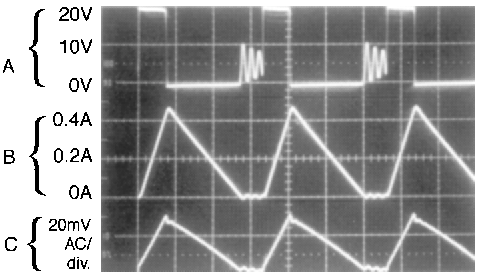
| Discontinuous mode switching waveforms | ||
| VIN = 20 V, VOUT = 5 V, ILOAD = 200 mA | ||
| L = 33 μH, COUT = 220 μF, COUT ESR = 60 mΩ | ||
| A: Output pin voltage, 10 V/div. | ||
| B: Inductor current, 0.2 A/div. | ||
| C: Output ripple voltage, 20 mV/div. |
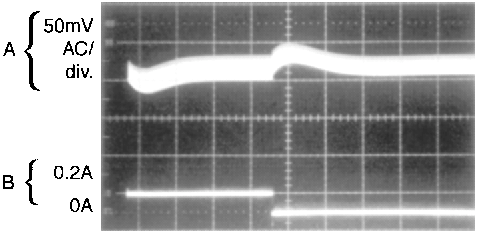
| Load transient response for discontinuous mode | ||
| VIN = 20 V, VOUT = 5 V, ILOAD = 100 mA to 200 mA | ||
| L = 33 μH, COUT = 220 μF, COUT ESR = 60 mΩ | ||
| A: Output voltage, 50 mV/div. (AC) | ||
| B: 100-mA to 200-mA load pulse | ||
9.2.2 Series Buck Regulator (Adjustable Output)
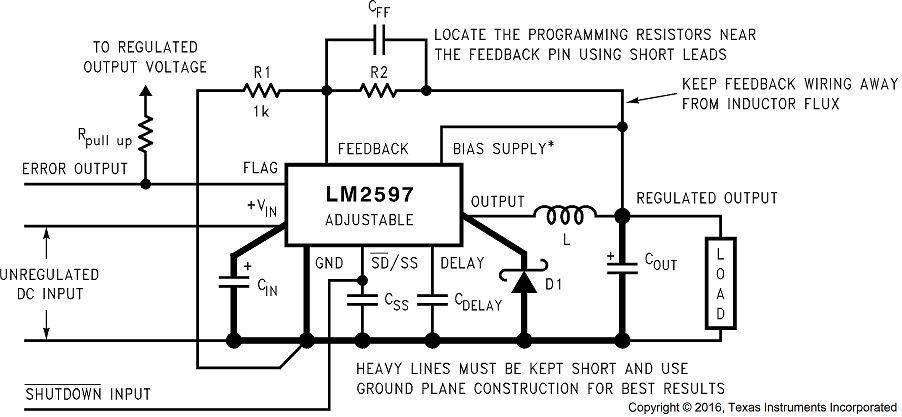

 Select R1 to be approximately 1 kΩ, use a 1% resistor for best stability.
Select R1 to be approximately 1 kΩ, use a 1% resistor for best stability. Component values shown are for VIN = 20 V,
VOUT = 10 V, ILOAD = 500 mA.
CIN – 68-μF, 35-V Aluminum Electrolytic, Nichicon PL Series
COUT – 120-μF, 25-V Aluminum Electrolytic, Nichicon PL Series
D1 – –1-A, 0-V Schottky Rectifier, 1N5818
L1 – 150-μH, L19
R1 – 1 kΩ, 1%
R2 – 7.15k, 1%
CFF – 3.3 nF
Typical Values
CSS – 0.1 μF
CDELAY – 0.1 μF
RPULL UP – 4.7k
*For output voltages between 4 V and 20 V
9.2.2.1 Design Requirements
Table 5 lists the design parameters for this application example.
Table 5. Design Parameters
| PARAMETER | EXAMPLE VALUE |
|---|---|
| Regulated output voltage, VOUT | 20 V |
| Maximum input voltage, VIN(max) | 28 V |
| Maximum load current, ILOAD(max) | 0.5 A |
| Switching frequency, F | Fixed at a nominal 150 kHz |
9.2.2.2 Detailed Design Procedure
9.2.2.2.1 Programming Output Voltage
Select R1 and R2, as shown in Figure 46.
Use Equation 1 to select the appropriate resistor values.

Select R1 with Equation 2 to be 1 kΩ, 1%. Solve for R2.

Select a value for R1 with Equation 3 between 240 Ω and 1.5 kΩ. The lower resistor values minimize noise pickup in the sensitive feedback pin. (For the lowest temperature coefficient and the best stability with time, use 1% metal film resistors.)

R2 = 1k (16.26 − 1) = 15.26k, closest 1% value is 15.4 kΩ.
R2 = 15.4 kΩ.
9.2.2.2.2 Inductor Selection (L1)
- Calculate the inductor Volt microsecond constant E • T (V • μs) with Equation 4.
- VSAT = internal switch saturation voltage = 0.9 V
- VD = diode forward voltage drop = 0.5 V
- Use the E • T value from the previous formula and match it with the E • T number on the vertical axis of the Inductor Value Selection Guide shown in Figure 41.
- On the horizontal axis, select the maximum load current.
- Identify the inductance region intersected by the E • T value and the Maximum Load Current value. Each region is identified by an inductance value and an inductor code (LXX).
- Select an appropriate inductor from the four manufacturer's part numbers listed in Table 2.

where
Calculate the inductor Volt • microsecond constant (E • T) with Equation 5.

E • T = 35.2 (V • μs)
ILOAD(max) = 0.5 A
From the inductor value selection guide shown in Figure 41, the inductance region intersected by the 35 (V • μs) horizontal line and the 0.5A vertical line is 150 μH, and the inductor code is L19.
From Table 2, locate line L19, and select an inductor part number from the list of manufacturers' part numbers.
9.2.2.2.3 Output Capacitor Selection (COUT)
- In the majority of applications, low ESR electrolytic or solid tantalum capacitors between 82 μF and 220 μF provide the best results. This capacitor must be located close to the IC using short capacitor leads and short copper traces. Do not use capacitors larger than 220 μF. For additional information, see Output Capacitor, COUT.
- To simplify the capacitor selection procedure, see Table 6 for a quick design guide. This table contains different output voltages, and lists various output capacitors that will provide the best design solutions.
- The capacitor voltage rating must be at least 1.5 times greater than the output voltage, and often much higher voltage ratings are required to satisfy the low ESR requirements required for low-output ripple voltage.
From Table 6, locate the output voltage column. From that column, locate the output voltage closest to the output voltage in your application. In this example, select the 24-V line. In Output Capacitor, COUT, select a capacitor from the list of through hole electrolytic or surface mount tantalum types from four different capacitor manufacturers. TI recommends that both the manufacturers and the manufacturers series that are listed in Table 6 be used.
In this example, through-hole aluminum electrolytic capacitors from several different manufacturers are available.
82-µF, 50-V Panasonic HFQ Series
120-µF, 50-V Nichicon PL Series
For a 20-V output, a capacitor rating of at least 30 V or more is required. In this example, either a 35-V or
50-V capacitor would work. A 50-V rating was chosen because it has a lower ESR which provides a lower output ripple voltage.
Other manufacturers or other types of capacitors may also be used, provided the capacitor specifications (especially the 100-kHz ESR) closely match the types listed in Table 6. Refer to the capacitor manufacturers' data sheet for this information.
9.2.2.2.4 Feedforward Capacitor (CFF)
For output voltages greater than approximately 10 V, an additional capacitor is required. The compensation capacitor is typically between 50 pF and 10 nF, and is wired in parallel with the output voltage setting resistor, R2. It provides additional stability for high output voltages, low input or output voltages, or very low ESR output capacitors, such as solid tantalum capacitors calculated with Equation 6 (see Figure 46).

This capacitor type can be ceramic, plastic, silver mica, and so forth (because of the unstable characteristics of ceramic capacitors made with Z5U material are not recommended.)
Table 6 contains feedforward capacitor values for various output voltages. In this example, a 1-nF capacitor is required.
9.2.2.2.5 Catch Diode Selection (D1)
- The catch diode current rating must be at least 1.3 times greater than the maximum load current. Also, if the power supply design must withstand a continuous output short, the diode must have a current rating equal to the maximum current limit of the LM2597. The most stressful condition for this diode is an overload or shorted output condition.
- The reverse voltage rating of the diode must be at least 1.25 times the maximum input voltage.
- This diode must be fast (short reverse recovery time) and must be placed close to the LM2597 using short leads and short-printed circuit traces. Because of their fast switching speed and low forward voltage drop, Schottky diodes provide the best performance and efficiency, and must be the first choice, especially in low output voltage applications. Ultra-fast recovery or high-efficiency rectifiers are also good choices, but some types with an abrupt turnoff characteristic may cause instability or EMl problems. Ultra-fast recovery diodes typically have reverse recovery times of 50 ns or less. Rectifiers such as the 1N4001 series must not be used because they are too slow.
Schottky diodes provide the best performance, and in this example a 1-A, 40-V, 1N5819 Schottky diode is a good choice. The 1-A diode rating is more than adequate and will not be overstressed even for a shorted output (see Table 1).
9.2.2.2.6 Input Capacitor (CIN)
A low-ESR aluminum or tantalum bypass capacitor is required between the input pin and ground to prevent large voltage transients from appearing at the input. In addition, the RMS current rating of the input capacitor must be selected to be at least ½ the DC load current. The capacitor manufacturers data sheet must be checked to assure that this current rating is not exceeded. Figure 34 shows typical RMS current ratings for several different aluminum electrolytic capacitor values.
This capacitor must be located close to the IC using short leads and the voltage rating must be approximately 1.5 times the maximum input voltage.
If solid tantalum input capacitors are used, TI recommend the capacitors are surge-current tested by the manufacturer.
CAUTION
Use caution when using ceramic capacitors for input bypassing, because it may cause severe ringing at the VIN pin.
The important parameters for the input capacitor are the input voltage rating and the RMS current rating. With a nominal input voltage of 28 V, an aluminum electrolytic aluminum electrolytic capacitor with a voltage rating greater than 42 V (1.5 × VIN) is required. Because the next higher capacitor voltage rating is 50 V, a 50-V capacitor must be used. The capacitor voltage rating of (1.5 × VIN) is a conservative guideline, and can be modified somewhat if desired.
The RMS current rating requirement for the input capacitor of a buck regulator is approximately ½ the DC load current. In this example, with a 400-mA load, a capacitor with a RMS current rating of at least 200 mA is required.
Figure 34 shows curves that can be used to select an appropriate input capacitor. From the curves, locate the 50-V line and note which capacitor values have RMS current ratings greater than 200 mA. A 47-μF, 50-V, low-ESR electrolytic capacitor is required.
For a through hole design, a 47-μF, 50-V electrolytic capacitor (Panasonic HFQ series or Nichicon PL series or equivalent) would be adequate. Other types or other manufacturers' capacitors can be used provided the RMS ripple current ratings are adequate.
For surface-mount designs, solid tantalum capacitors are recommended. The TPS series available from AVX, and the 593D series from Sprague are both surge current tested.
For additional information, see Input Capacitor, CIN.
Table 6. Output Capacitor and Feedforward Capacitor Selection Table
| OUTPUT VOLTAGE (V) |
THROUGH-HOLE OUTPUT CAPACITOR | SURFACE-MOUNT OUTPUT CAPACITOR | ||||
|---|---|---|---|---|---|---|
| PANASONIC | NICHICON PL | FEEDFORWARD | AVX TPS | SPRAGUE | FEEDFORWARD | |
| HFQ SERIES (μF/V) |
SERIES (μF/V) |
CAPACITOR | SERIES (μF/V) |
595D SERIES (μF/V) |
CAPACITOR | |
| 1.2 | 220/25 | 220/25 | 0 | 220/10 | 220/10 | 0 |
| 4 | 180/25 | 180/25 | 4.7 nF | 100/10 | 120/10 | 4.7 nF |
| 6 | 82/25 | 82/25 | 4.7 nF | 100/10 | 120/10 | 4.7 nF |
| 9 | 82/25 | 82/25 | 3.3 nF | 100/16 | 100/16 | 3.3 nF |
| 12 | 82/25 | 82/25 | 2.2 nF | 100/16 | 100/16 | 2.2 nF |
| 15 | 82/25 | 82/25 | 1.5 nF | 68/20 | 100/20 | 1.5 nF |
| 24 | 82/50 | 120/50 | 1 nF | 10/35 | 15/35 | 220 pF |
| 28 | 82/50 | 120/50 | 820 pF | 10/35 | 15/35 | 220 pF |
9.2.2.3 Application Curves
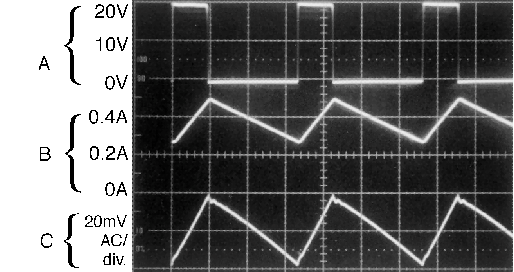
| Continuous mode switching waveforms | ||
| VIN = 20 V, VOUT = 5 V, ILOAD = 400 mA | ||
| L = 100 μH, COUT = 120 μF, COUT ESR = 140 mΩ | ||
| A: Output pin voltage, 10 V/div. | ||
| B: Inductor current, 0.2 A/div. | ||
| C: Output ripple voltage, 20 mV/div. |
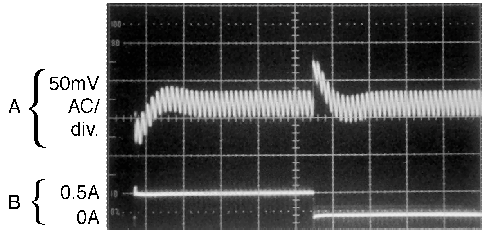
| Load transient response for continuous mode | ||
| VIN = 20 V, VOUT = 5 V, ILOAD = 200 mA to 500 mA | ||
| L = 100 μH, COUT = 120 μF, COUT ESR = 140 mΩ | ||
| A: Output voltage, 50 mV/div. (AC) | ||
| B: 200-mA to 500-mA load pulse | ||